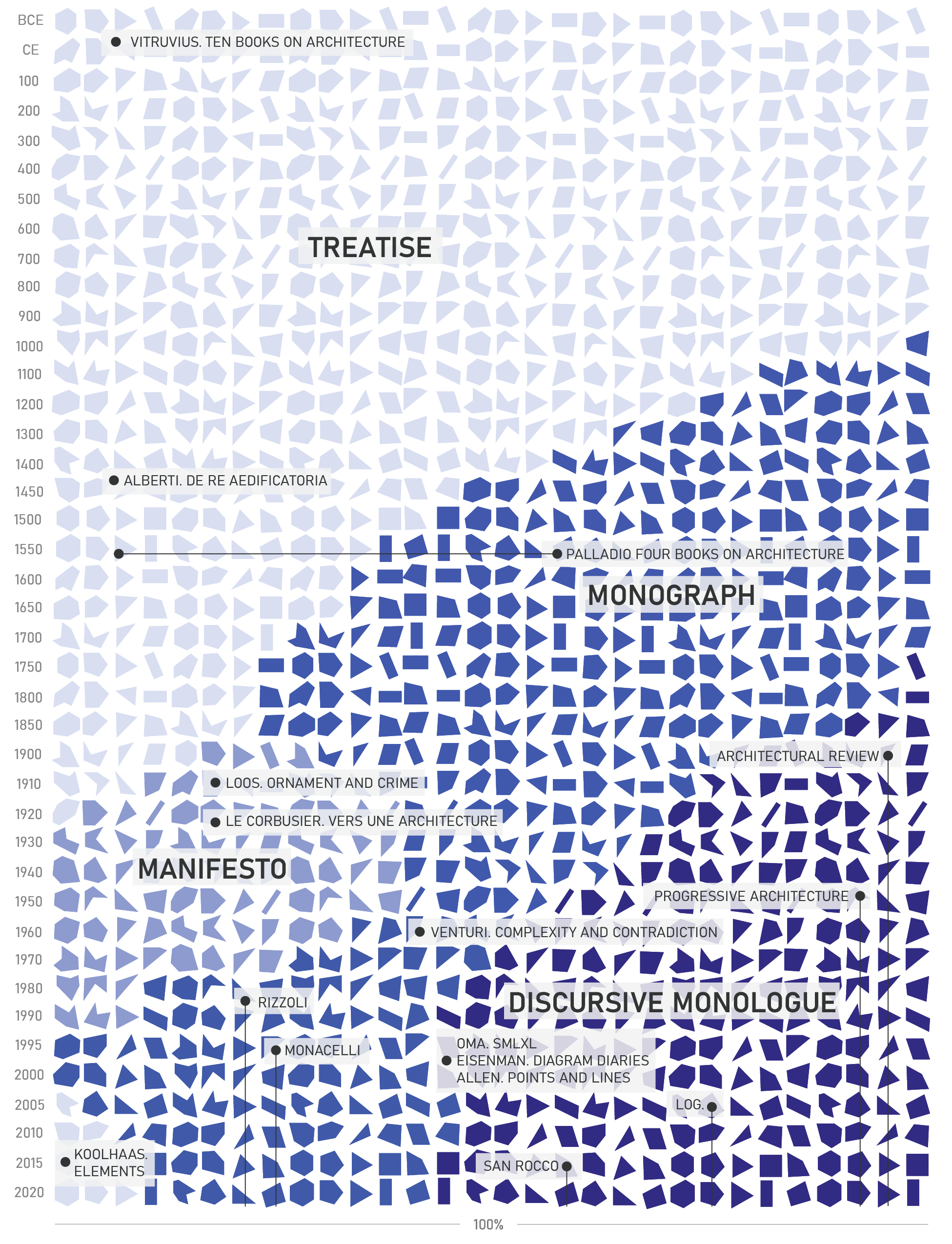Text Sub-Products over Time
60 BCE—1400 CE
Vitruvius wrote the oldest surviving treatise, which was copied and preserved throughout the middle ages. It was accompanied by ancient trade manuals such as Mappae clavicula.
1400—1500 Alberti’s De re aedificatoria is based mainly on the work of Vitruvius and became the first printed book on architecture.
1500—1700
Palladio’s I quattro libri dell'architettura blurred the lines between the monograph and the treatise, using the author’s projects as a reference to understand universal architectural ideals.
1700—1850 The formal architectural monograph becomes a means for architects to advertise their services and share their work with others in the profession. Sir John Soane published five separate monographs in his life.
1850—1900
The rise of printing and literacy led to the publication of journals such as the Architectural Review. This gives rise to the discursive monologue, a position paper about architecture.
1900—1950 The manifesto replaces the treatise with the rise of modern architecture. It states what architecture should be rather than what it is. Le Corbusier’s Vers une architecture led other architects to take absolute positions leading to experimental writing informed by radical thought.
1950—2000 Postmodern thinking softens the absolutist positions of the previous generation. Venturi’s Complexity and Contradiction, a series of architectural essays followed by the author’s work, blurs the lines between monograph and discursive monologue. On the eve of the new millennium, OMA, Eisenman, and Stan Allen all publish seminal texts about their work and positions on architecture.
2000—2020
The rise of architectural journals attempts to keep pace with shortened attention spans of the modern reader. Each issue often focuses on a new topic, presenting multiple perspectives before moving on. Koolhaas revives the treatise with Elements, a tome that dissects architecture into parts.
60 BCE—1400 CE
Vitruvius wrote the oldest surviving treatise, which was copied and preserved throughout the middle ages. It was accompanied by ancient trade manuals such as Mappae clavicula.
1400—1500 Alberti’s De re aedificatoria is based mainly on the work of Vitruvius and became the first printed book on architecture.
1500—1700
Palladio’s I quattro libri dell'architettura blurred the lines between the monograph and the treatise, using the author’s projects as a reference to understand universal architectural ideals.
1700—1850 The formal architectural monograph becomes a means for architects to advertise their services and share their work with others in the profession. Sir John Soane published five separate monographs in his life.
1850—1900
The rise of printing and literacy led to the publication of journals such as the Architectural Review. This gives rise to the discursive monologue, a position paper about architecture.
1900—1950 The manifesto replaces the treatise with the rise of modern architecture. It states what architecture should be rather than what it is. Le Corbusier’s Vers une architecture led other architects to take absolute positions leading to experimental writing informed by radical thought.
1950—2000 Postmodern thinking softens the absolutist positions of the previous generation. Venturi’s Complexity and Contradiction, a series of architectural essays followed by the author’s work, blurs the lines between monograph and discursive monologue. On the eve of the new millennium, OMA, Eisenman, and Stan Allen all publish seminal texts about their work and positions on architecture.
2000—2020
The rise of architectural journals attempts to keep pace with shortened attention spans of the modern reader. Each issue often focuses on a new topic, presenting multiple perspectives before moving on. Koolhaas revives the treatise with Elements, a tome that dissects architecture into parts.

